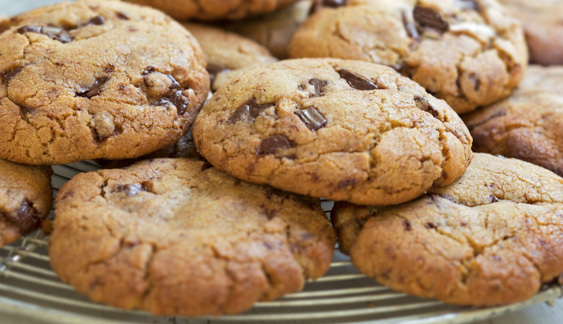Bennecake and Browned Butter Chocolate Chip Cookies

introduction
It’s the taste that launched a thousand chips, the cookie by which small retail food stores everywhere stake their reputations, the cookie whose raw dough is even more tantalizing than its baked self, the cookie that offers both chew and goo. Yes, that cookie. When our editor, Dawn, said she wanted to take a swing at developing a recipe for chocolate chip cookies with bennecake, we were in. Not only did it sound like a natural coupling of ingredients, it also—more seductively—sounded like a great excuse to invite some cookies over to our house for a few weeks without feeling guilty. We waited while Dawn initiated recipe trials and grumbled about cookie dough accumulating in her fridge. We salivated over iPhone shots of chubby cookies glistening with chocolate. We pretended to sympathize when Dawn said she couldn’t choose between bennecake chocolate chip cookies and “plain ole.” We were thrilled to finally get our teeth on both recipes.
How to choose? It was like trying to choose between fraternal twins. Here they are. Can you tell them apart? The cookie with bennecake has a touch more palate sophistication—a little je ne sais quoi nuttiness dancing around the edges. The cookie without bennecake comes through as more buttery and toffee-like. Both have the requisite hallmarks of great chocolate chip cookies: great chocolate (chopped off the old block); the warm stirring notes of vanilla; a crispy edge that moves into a sensual brown sugar and butter chew; and a well-upholstered backside. Oh, and something else: the butter is browned. Appeal just tripped the charts. You choose.
Baking Notes
As we’ve said, the cookies are equally good made simply with pastry flour and no bennecake. To try our recipe for Basic Superb Chocolate Chip Cookies, omit the bennecake and increase the pastry flour to 9 ounces (1¾ cups plus 1 tablespoon). Everything else is the same.
equipment mise en place
For this recipe, you will need a digital kitchen scale, a 10-inch heavy-bottomed skillet, a small heavy-bottomed saucepan, a medium bowl, a large heatproof bowl, a whisk, a rubber spatula, two baking sheets, parchment paper, and a wire rack.
-
-
2ounces (½ cup) Anson Mills New Crop Heirloom Bennecake Flour
-
5ounces (10 tablespoons) unsalted European-style butter
-
6ounces (1 cup plus 3½ tablespoons) Anson Mills Colonial Style Fine Cloth-Bolted Pastry Flour
-
1teaspoon baking powder
-
¼teaspoon baking soda
-
3.5ounces (½ cup packed) light brown sugar
-
3.5ounces (½ cup) granulated sugar
-
2teaspoons vanilla extract
-
¾teaspoon fine sea salt
-
1large egg
-
5ounces good-quality bittersweet chocolate (65 to 70 percent cocoa) in a thin bar (not a thick block), chopped into ¼-inch pieces
-
-
In a 10-inch heavy-bottomed skillet, toast the bennecake, stirring frequently, until golden and fragrant, 8 to 10 minutes (fig. 1.1). Transfer the flour to a medium bowl and let cool.
-
While the bennecake is toasting, melt the butter in a small heavy-bottomed saucepan over medium heat, stirring frequently, until the milk solids are deeply browned and the butter has the aroma of toasted nuts, about 10 minutes (fig. 2.1). Pour the butter into a large heatproof bowl, stir for 30 seconds or so to release some of the heat, and let cool until barely warm to the touch.
-
Add the pastry flour, baking powder, and baking soda to the cooled bennecake and whisk well to combine.
-
Toss the brown sugar and granulated sugar together in a small bowl and work it together with your fingers to smooth away any lumps. Add the sugar, vanilla, and salt to the cooled browned butter and whisk until the sugar is evenly moistened. Add the egg and whisk vigorously (fig. 4.1). Empty the dry ingredients into the butter-sugar mixture and stir with a rubber spatula until almost completely incorporated. Dump in the chopped chocolate and continue to mix until the chocolate is evenly distributed throughout the dough (fig. 4.2). Cover the bowl with plastic wrap and set aside to allow the dough to hydrate while the oven heats. (At this point, the dough can be refrigerated for up to 3 days. Allow it to come back to room temperature before portioning and baking.)
-
Adjust an oven rack to the middle position and heat the oven to 350 degrees. Line two baking sheets with parchment paper.
-
When the oven has come up to temperature, form the dough into sixteen or seventeen 1.5-ounce balls (each about 2 tablespoons in volume). Divide the dough balls between the baking sheets, evenly spacing them. With your hand, gently press down on each ball to flatten it ever so slightly (fig. 6.1). Bake one baking sheet at a time until the cookies are golden brown, 11 to 12 minutes. Let cool on the baking sheet on a wire rack for at least 10 minutes before removing with a metal spatula. The cookies are best eaten within a few hours of baking, but once cooled, can be kept in an airtight container for up to 3 days.
-
-
1.1

-
-
-
2.1

-
-
-
4.1

-
4.2

-
-
-
6.1

-